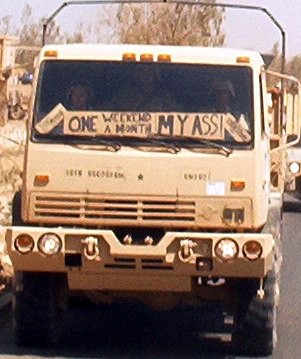Found 3599 matches from 1,400 records in about 0.1092 seconds for twitter or is or lazy.
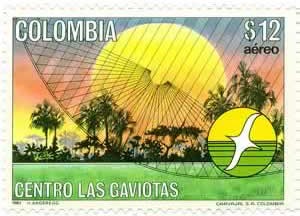
In 1965 Paulo Lugari was flying over the impoverished Llanos Orientales, the “eastern plains” that border Venezuela. The soil of the Llanos is tough and acidic, some of the worst in Colombia. Lugari mused that if people could live here they could live anywhere.
The following year Lugari and a group of scientists, artists, agronomists and engineers took the 15-hour journey along a tortuous route from Bogota to the Llanos Orientales to settle. The local population, including the indigenous Guahibo people, familiar with the political terror and violence of the ‘white man,’ were naturally suspicious.
Nearly 40 years later, while war rages across Colombia with the help of U.S. funds, equipment, and training, the 200 residents of Gaviotas, including farmers, scientists, artists, and former street kids, have created a thriving village and environmental research center in Vichada in Los Llanos.
“Gaviotas is named after a bird that enlivens the rivers at dusk.” [source]
“They have planted millions of trees, thus regenerating an indigenous rainforest. They farm organically and use wind and solar power. Every family enjoys free housing, community meals, and schooling. There are no weapons, no police, no jail. There is no mayor.” [source]
“Gaviotas provided a chance to plan a tropical civilization from the ground up, instead of depending on technologies developed for northern climates. ‘When we import solutions from the US or Europe,’ said Lugari, founder of Gaviotas, ‘we also import their problems.’
Over the years Gaviotas technicians have installed thousands of the windmills across Colombia - in some places gaviotas is the local word for windmill.”
Around 58 types of windmill were tried and tested before the pioneers came up with determined that the distinctive ‘sunflower’ design functioned best in the plains.
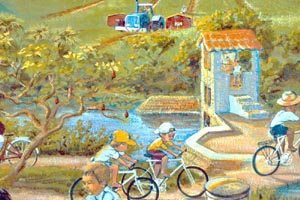 “Since Gaviotas refuses to patent inventions, preferring to share them freely, the design has been copied from Central America to Chile.
“Since Gaviotas refuses to patent inventions, preferring to share them freely, the design has been copied from Central America to Chile.
Electricity comes from a low-head turbine powered by a stream, except in the short dry season, when it is backed up by a diesel generator. ‘In 24 years we’ve learned to cover 70 percent of our food and energy needs,’ says Gonalo Bernal, administrator of Gaviotas. ‘The trees we plant more than compensate for any greenhouse gases we emit. Imagine if the rest of the world lived like us.’
Gaviotas began as a collection of researchers, students, and laborers sharing vehicles, bedding, dishes, clothes - and decisions. In time several of their families joined them and a permanent colony with individual houses emerged. Government was by consensus and unwritten rules. To limit public disorder, alcohol is confined to homes. To preserve wildlife, dogs and guns are banished. A need for police, jail, or door locks has never arisen. Anyone who violates protocol, like a storekeeper who recently admitted to overcharging, is ostracized by the community until his debt is paid. Loafers aren’t tolerated, but with wages above the Colombian minimum wage, plus free meals, medical care, schools, and housing, loafing isn’t a problem.
A techno-tour of the llanos shows how Gaviotas has revolutionized life here. The most significant invention is a simple hand pump capable of tapping aquifers six times deeper than conventional models, but requiring so little effort that children can operate it. In normal pumps a heavy piston must be raised and lowered inside a pipe. Gaviotas engineers realized they could do the reverse; leave the piston stationary and lift an outer sleeve of lightweight, inexpensive PVC tubing instead.”
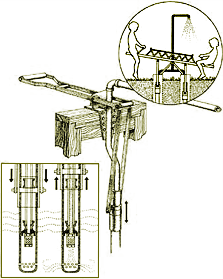 “In the open-air Gaviotas preschool, the children’s see-saw is actually a pump in disguise. As they rise and descend, water gushes from a vertical pipe into an open cement tank. Over the years Gaviotas technicians have installed these in thousands of school yards, using kid power to provide villages with clean water. This simple, inexpensive pump has revolutionised rural life across Colombia for people who used to haul their water in buckets from muddy tropical rivers.” [source]
“In the open-air Gaviotas preschool, the children’s see-saw is actually a pump in disguise. As they rise and descend, water gushes from a vertical pipe into an open cement tank. Over the years Gaviotas technicians have installed these in thousands of school yards, using kid power to provide villages with clean water. This simple, inexpensive pump has revolutionised rural life across Colombia for people who used to haul their water in buckets from muddy tropical rivers.” [source]
“At a windmill-fed cattle trough, surrounded by a sloping cement floor, cowboys have just brought several thirsty calves. As they drink, their dung slides down the slope into a gutter, which sluices it to an enclosed anaerobic fermentation tank, where the cow-pie slurry turns into compost and methane.
The methane flows through pipes to the 16-bed Gaviotas hospital, which a Japanese architectural journal has named one of the 40 most important buildings in the world. It is at once both futuristic and ancient, a maze of angles formed by white walls, glass awnings, skylights, brushed steel columns, and exposed supports trimmed in blue and yellow enamel. The interior is cooled with underground ducts whose hillside intakes face the prevailing breeze. Opposing layers of corrugated roofing create a series of air channels that further bleed away the heat. The combined effect is cost-free, maintenance-free air conditioning. Solar collectors on the roof alternately heat, boil, and distill water. Electricity is from solar photovoltaic cells.
The only hospital within a 12-hour radius, it serves all comers, including both guerrilla and army forces battling in the area. ‘The rule here is never to ask,’ says Bernal. ‘Like the Red Cross, everybody respects us.’
A short, vine-covered walkway connects the Gaviotas hospital to the maloks, a separate wing built by the local Guahivo Indians. Instead of beds, patients and their families lie in hammocks hung from wooden beams under a great thatch roof. Relatives of the sick tend crops of tomatoes, lettuce, and onions in an adjacent hydroponic greenhouse.
If the National University’s pharmacology department and the Guahivo shamans have their way, this greenhouse will one day become the finest medical plant laboratory in the tropics. But money is a critical factor, and Colombia’s expanding, government-owned oil and gas industry has dampened Gaviotas’ solar collector sales by blocking tax benefits for investing in alternative energy. At  the same time revenue from windmills and pumps dropped as Colombian agriculture was battered by an unexpected onslaught of cheap imported foods, the fallout of new free trade policies.
the same time revenue from windmills and pumps dropped as Colombian agriculture was battered by an unexpected onslaught of cheap imported foods, the fallout of new free trade policies.
So Gaviotas has decided to scale down its manufacturing. But no one is getting laid off. ‘Gaviotas isn’t a company,’ Lugari says, ‘we’re a community. In fact the solution means that both employment and Gaviotas will grow.’
The solution is the nearly 20,000 forested acres. In the past 12 years, Gaviotas has planted 1.6 million Caribbean pines (after finding that no indigenous tree would grow on the prairie). To the surprise of foresters, Gaviotans chose not to cut their standing timber. Instead they are converting their windmill factory to process pine resin. Colombia spends $4 million annually to import such resins for the manufacture of paint, turpentine, and paper. Armed with that fact, Lugari persuaded the Japanese government to provide the seed money, via a grant through the Interamerican Development Bank, to begin tapping and processing resin for the domestic market.” [source]
Since the above was written in 1995, the community no longer purhcases diesel fuel and is now totally energy independent. They generate power with turbine engines fueled by the resin of the Carribean pine trees in their forest. These pines are being slowly crowded out by the regeneration of indigenous rainforest. [source]
Other inventions include:
- a high pressure solar cooker
- methane burners
- hot-water solar panels
- parabolic solar grain driers
- self-cooling rooftops
- cooling wind corridors
- corkscrewing manual well digger
- variety of highly efficient and durable windmills
- specialized bicycle for the Llanos
- pedal powered cassava grinder (10 hours work done in 1 hour)
- rotating drum peanut sheller
- ox-drawn land graders
- one-handed sugarcane press
Gaviotas engineers also designed a solar kettle for the hospital. According to engineer Jaime Dávila, “the principle begins with an old country custom: boil water one day to drink the next, after it cools.” Dávila’s goal was an inexpensive solar-operated system that would give unlimited boiled drinking water, already cooled to room temperature, straight from a tap any time of day, and would work under cloudy skies. The kettle took six years to perfect. It combines solar panels, storage tanks, an efficient heat exchanger, a bit of distillation and a spigot — which you turn to draw off potable water.[source]
See some renderings of their solar collectors, solar oven, and wind-powered musical organ.
From the Chicago Tribune, July 26, 2003:
Greening of the Iron Curtain
Gorbachev backs proposal to make border a preserve
“Mikhail Gorbachev, who as Soviet leader presided over the troops and tanks that guarded the Iron Curtain, now wants a nature reserve along the full length of the former Cold War border, from Finland to the Adriatic.
German and other European environmental groups have devised a plan to create nature parks out of the no man’s land that separated the Soviet bloc from the West.
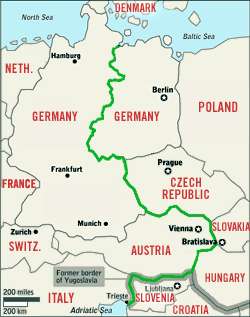 Kept forcibly free of people during more than 40 years of the Cold War, the border between Eastern and Western Europe became a refuge for plants and animals. Construction in the region now threatens these unintentional but important nature reserves, environmentalists fear.
Kept forcibly free of people during more than 40 years of the Cold War, the border between Eastern and Western Europe became a refuge for plants and animals. Construction in the region now threatens these unintentional but important nature reserves, environmentalists fear.
‘Ecology isn’t something we can only leave to politicians,’ Gorbachev, who is president of the environmental organization Green Cross International, said when lending his support to the project at a recent conference in Bonn, Germany.
Although the idea of making parks along former Cold War borders has been around since the fall of the Berlin Wall in 1989, the conference was the first time that representatives of all the border countries had met to discuss the feasibility of having parkland run the length of what was the Iron Curtain.
Plans for the park are furthest along in Germany, where the border between East and West Germany once stretched for 870 miles. A recent study found that 85 percent of the land is still undeveloped enough to be included in a national park.
Plans were delayed while courts determined the status of the land, but most claims are now settled, and the German Finance Ministry recently announced it might be able to donate the 65 percent of former border land still in government possession.
Environmentalists emphasize that the reserve would not simply be the area it covered or the number of endangered species it contained but also that it would link many groups of organisms, known as biotopes, in the longest continuous stretch of undeveloped land left in Central Europe.
In the other former border countries, plans for a park are in only their early phases. The most likely route would be around the eastern half of Austria to the Adriatic, while another area would encompass Albania, whose border with Yugoslavia was always heavily guarded, and would then pass along the northern border of Greece.
Several speakers at the conference observed that Gorbachev — who could have rolled back Eastern Europe’s anti-Communist revolutions by force as his predecessors did — was on hand and had, in effect, made the border park possible.
Steffen Flath, the environment minister of what is now the German state of Saxony, once part of Communist East Germany, turned to Mr. Gorbachev and said, ‘I remember July 1989 when things were starting to bubble, and our government said, “Send us tanks,” and you, Mr. Gorbachev, you didn’t send those tanks.’
With the congratulatory words about vanishing borders in central Europe, however, some of those who follow events in this part of the world feared that events farther east were being ignored. Tamas Marghescu, European director of the World Conservation Union, said nervous states about to join the European Union were creating new divides. He cited what he said was a new impenetrable fence along the border between Poland and Belarus, which he said split an important park that straddles the border. ‘It’s the new Iron Curtain,’ he said.”
The Thayatal National Park, in Austria, and the Podyji National Park in the Czech Republic already exist along the river known in Austria as the Thaya, and in Czech as the Dyje, a former boundary of the Iron Curtain. [more]
via Planetizen
Reader Desmond B. writes:
“Browsing through your site, I was interested by your relatively neutral presentation of the ISO programme. You presented some interesting aspects of the bureaucratic inanities, as well as some of the difficulties of applying euro-centric standards (the symbology not being applicable worldwide) on a global scale. It seems as though there are many positive aspects to the ISO programme (your mention of Toyota’s practices), it appears that there is relatively little citizen/democratic control or oversight of this organisation. It’s one thing to standardise container sizes, but environmental management procedures should perhaps be a more public affair. Curious to see some critical comment from you regarding this, especially considering the frequent mentions of ISO on your site.”
True enough. In my two posts that mention the ISO I was fairly neutral. I was less concerned about democratic accountability of the ISO because the standard setting process is fairly open and decentralized, and standards compliance is entirely voluntary. It is up to governments, not the ISO, to legislate, regulate, or enforce implementation of the standards.
 Standards are developed by consensus of broad-based technical committees and working groups. According to the ISO site:
Standards are developed by consensus of broad-based technical committees and working groups. According to the ISO site:
“In these committees, qualified representatives of industry, research institutes, government authorities, consumer bodies, and international organizations from all over the world come together as equal partners in the resolution of global standardization problems.”
Though the views of these interests are taken into account in the standard development process, only ISO “member bodies” can actually participate in the final vote. A member body of ISO is the national body ‘most representative of standardization in its country’. Only one such body is accepted from each country.
That said, the ISO’s consensus process is becoming less open:
“As part of the streamlining of existing procedures, ISO committees will in future, subject to certain conditions, have the option of dispensing with the committee stage — the part of the ISO process during which national positions are debated in order to reach consensus within an ISO committee — and with the final approval stage, during which the texts of final standards are submitted for formal approval by the full ISO membership.” [source]
The ISO’s patent policy highlights the need for more public participation, accountability, and oversight.
The ISO requires individual or corporation’s holding patent rights on any part of an ISO standard to grant usage rights freely or under “reasonable and non-discriminatory terms and conditions” that apply throughout the world. While this may seem fair, the working committee of the relevant standard determines what is “reasonable and non-discriminatory.” This policy has kept some technical standards out of the public domain and from being implemented in some Free Software projects. For instance, it is impossible to write Free Software which can encode or decode MPEG-2 video or encode or decode MPEG-1 Layer 3 audio in the United States. When the organzation that sets standards for the Internet, the W3C, floated its own draft policy considering “reasonable and non-discriminatory” licensing fees, it was widely condemned in public comment and eventually dropped in favor of a draft with royalty-free licenses.
As Desmond notes, though, environmental management procedures are a different matter from, say, standard paper sizes.
The major requirements of an Environmental Management System (EMS) under ISO 14001 include:
- Issuing a policy statement which includes commitments to prevention of pollution, continual improvement of the EMS leading to improvements in overall environmental performance, and compliance with all applicable statutory and regulatory requirements.
- Identification of all aspects of the community organization’s activities, products, and services that could have a significant impact on the environment, including those that are not regulated
- Setting performance objectives and targets for the management system which link back to the three commitments established in the community or organization’s policy (i.e. prevention of pollution, continual improvement, and compliance)
- Implementing the EMS to meet these objectives. This includes activities like training of employees, establishing work instructions and practices, and establishing the actual metrics by which the objectives and targets will be measured.
- Establishing a program to periodically audit the operation of the EMS
- Checking and taking corrective and preventive actions when deviations from the EMS occur, including periodically evaluating the organization’s compliance with applicable regulatory requirements.
- Undertaking periodic reviews of the EMS by top management to ensure its continuing performance and making adjustments to it, as necessary. [source]
“ISO 14001 does not establish performance requirements or specific criteria and indicators for defining sustainable forestry. Among the misleading practices that ISO wants to put an end to [is]... giving the false impression that... ISO 14000 is a label signifying a ‘green’ or ‘environmentally friendly’ product. This is not so. They are not product standards.” [source]
Nor does the auditing process include public oversight.
“Companies write their own public environmental policies — compliance with these policies, or even compliance with the law, is not a condition of certification. ISO 14001 certifications neither audit nor verify on-the-ground environmental performance. Public consultation is not a requirement of the certification process, nor are public summaries of certification audits required. Because ISO 14001 has no forestry performance standards, any forestry company — from the most environmentally destructive to the most well-managed — can be certified. Contrary to claims by the Canadian Pulp and Paper Association, third party audits to the ISO 14001 standard do not ‘ensure sustainable forestry’.” [source]
Indeed, Greenpeace criticizes the ISO 14001 standard and its use by the Vancouver-based company International Forest Products (Interfor) to “greenwash” its logging operations in old growth rainforests along the coast of British Columbia.
“Weaknesses of the ISO 14001 standard include:
- Compliance with the environmental policy, or even compliance with the law, is not a requirement of certification — the company sets the environmental policy
- ISO 14001 neither sets nor endorses any environmental performance standards, in forestry or in any other industrial sector
- ISO 14001 certifications neither audit nor verify on-the-ground environmental performance
- Public consultation is not a requirement of the certification process, nor are public summaries of certification audits required
- ISO 14001 is not an environmental labeling system
- ISO has no effective controls to prevent misleading marketing claims related to ISO 14001 certifications.
Environmental management system (EMS) certification schemes are completely different from environmental labeling schemes. As the ISO points out, “Two organizations carrying out similar activities but having different environmental performance may both comply with its [EMS] requirements.”
Environmental labeling, on the other hand, requires performance above a threshold. The environmental label is only awarded if a product or service has reached this level. The distinction between ISO 14001 and environmental labeling is essential. Because ISO 14001 has no forestry performance standards, any forestry company — from the most environmentally destructive to the most sustainable — can be certified. An ISO 14001 certification tells the consumer nothing about the relative environmental performance of any company’s, including Interfor’s, forestry operations.” [source] (Emphasis added.)
A U.S. reservist in Iraq emails a photo to a friend back home. Friend posts it on his blog. The image is widely circulated by email, and ultimately finds mention in The New York Times a month later.
The war drags on. Tours of duty are extended. U.S. soldiers continue to kill and be killed. Dissent among the military and military families smoulders.
And the scholarship funding? Job skills? Veteran’s benefits? One weekend a month?
See these articles about the myths and messages in military graphics and advertising sold by recruiters to high school and college students across the United States of America.
In 1986, Guinea Worm Disease infected an estimated 3.5 million people living in rural agricultural communities in 16 African countries, parts of India, Pakistan, and Yemen. The disease is extremely painful and debilitating, contracted by drinking water containing larvae of the parasite Dracunculus medinensis. The disease has plagued humanity for thousands of years. Today, after a decade’s campaign of education and the design and distribution of a special fabric, the disease has been virtually eliminated.
 “Dracunculus medinensis has been traced to calcified worms in the stomachs of Egyptian mummies during the first millenium. Records of infection and treatment have been found dating back to 1530 BC. The Guinea worm is believed to be the ‘fiery serpent’ mentioned in the Bible, that infected the Hebrews during their exodus from Egypt. The medical symbol ‘Caduceus’ is believed to represent two coiled Guinea worms.” [source]
“Dracunculus medinensis has been traced to calcified worms in the stomachs of Egyptian mummies during the first millenium. Records of infection and treatment have been found dating back to 1530 BC. The Guinea worm is believed to be the ‘fiery serpent’ mentioned in the Bible, that infected the Hebrews during their exodus from Egypt. The medical symbol ‘Caduceus’ is believed to represent two coiled Guinea worms.” [source]
A Sanskrit poem from the 14th century B.C. includes the plea, “Let not the sinuous worm strike me nor wound my foot.” [source]
“Victims must endure the worm’s painful emergence for as long as three months, and are usually incapacitated not only by the pain but by fever, fatigue, and nausea as well. To speed things along, people carefully wind the worm around a stick as it emerges [as depcted in the ‘Caduceus’], being careful not to pull too hard. If the worm breaks, it will retract into the body, causing severe inflammation. Over half of all worm-emergence sites become infected, and the worst cases can result in permanent crippling or even death from tetanus.” [source]
There is no preventive or curative drug. However, the disease is relatively easy to prevent — drinking contaminated water is the only way to acquire the disease.
“Measures to prevent [Guinea Worm Disease] are community-based and inexpensive. Control methods include health education, providing safe drinking water, using filters to remove infected copepods from drinking water, boiling water or treating it with small doses of temephos, a colorless, odorless chemical that, kills copepods but is harmless to people.” [source]
 “The cycle of transmission can easily be broken by filtering drinking water and preventing infected people from entering drinking water sources. [The worm] has no reservoir other than humans. When the worm’s one-year life cycle is broken for two years, the disease is permanently eliminated from the area. This is the only disease that can be eradicated by providing clean drinking water....
“The cycle of transmission can easily be broken by filtering drinking water and preventing infected people from entering drinking water sources. [The worm] has no reservoir other than humans. When the worm’s one-year life cycle is broken for two years, the disease is permanently eliminated from the area. This is the only disease that can be eradicated by providing clean drinking water....
Water contaminated with guinea worm is safe for drinking (as far as this disease is concerned) if the water is filtered through a tightly woven cloth.
Inexpensive, effective cloth is available in most local African markets, and 1 million square meters of special synthetic fabric, for more rapid water filtration, has been donated by DuPont, with additional synthetic cloth donated by the Danish government and others.
Agricultural and school projects, along with company advertising, can teach people about guinea worm and how to protect themselves. Farmers who drink from ponds during the day should have a filter with them.” [source]
The filter must always be used with the same side up, usually marked with a printed symbol or instructions.
Since 1986, local, national, and international campaigns have had dramatic success. The disease has been virtually eliminated.
“The Carter Center joined the fight against Guinea worm in 1986, when it helped Ghana and Pakistan launch their eradication programs. Since then, it has spearheaded the World Health Organization’s global eradication effort, aimed at making Guinea worm only the second disease, after smallpox, to be wiped out completely. Under the leadership of the Carters and Dr. Donald Hopkins, the Carter Center has raised money, provided technical expertise, forged partnerships, and mustered the political will necessary to achieve this ambitious goal. They have distributed portable filters and initiated education programs to help break the cycle of the worm.
Transmission has been stopped in seven countries, and Asia is now free of the disease. In 2001, fewer than 65,000 cases remained in thirteen African countries, a 98 percent reduction since the beginning of the effort. Experts are confident that total eradication is just around the corner.
In 2001, it was estimated that 80 percent of the remaining cases were in the Sudan, where civil war has prevented a major eradication effort. That same year, courageous Carter Center volunteers distributed 8.5 million pipe filters, enough for every man, woman and child in the endemic areas of the Sudan. These hard plastic straws with nylon filters at one end can be carried around the neck and allow nomadic peoples to strain their water before drinking.” [source]
At the request of President Carter in 1990, DuPont developed a nylon monofilament filtration fabric to filter water infested with the Guinea worm parasite. The fabric is manufactured by Precision Fabrics:
“This fabric was unique. It had never been produced in this country. It is woven using a very fine monofilament nylon yarn. The fabric is washed, stabilized and finished to control the pore size of the fabric. It is precision slit into 12-inch wide rolls for export to the countries plagued by the disease. The fabric is then used in villages to filter water sources.”
DuPont and Precision Fabrics donated millions of square yards of the fabric from 1990 to 1997. Other countries have also produced similar fabric filters.
...
The Guinea Worm Filter is my suggestion to “100 ‘Cubes of Good Ideas’”, an exhibition of “objects that change people’s lives.” Design for the World is organizing the exhibition, which takes place during the Universal Forum of Cultures in Barcelona in the summer of 2004.
It looks like a botanical garden, but it’s feasting on your sewage — reclaiming waste water for reuse. It’s bioremediation in action. It’s... a Living Machine, “a natural engine to clean water, grow food, regulate climate, even repair damaged habitats.”

“Living Machines accelerate nature’s own water purification process. Unlike chemically based systems, Living Machines incorporate helpful bacteria, plants, snails and fish that thrive by breaking down and digesting organic pollutants.
Wastewater treatment takes place through a series of differently managed environments, a diversity of organisms that eat the waste in the water.
Each Living Machine is custom designed by the engineers of Living Machines, Inc.
Living Machines, Inc. designs each Living Machine to meet each individual client’s needs and requirements. Living Machines typically treat wastewater with six different steps (reactors) or ecologies.”
Though the outputs are not drinkable, there are a variety of agricultural and industrial uses for the processed water.
More than thirty commercial-scale and pilot facilities located throughout the United States and seven other countries, range in size between 300 and 750,000 gallons per day.
The Living Machine system in South Burlington, Vermont cleans 80,000 gallons per day of municipal sewage, an amount typically generated by approximately 1,600 residential users. The waste stream is diverted from the City’s conventional treatment plant. Waste water from the Ethel M Chocolates plant runs through a Living Machine system:
“The treated wastewater is suitable for reuse for on-site landscape irrigation. Sludge is also treated on-site by a composting reed bed, making this a zero discharge facility.”
...
Ocean Arks International is a non-profit organization founded by Living Machine inventor John Todd. Ocean Arks applies the concepts behind the Living Machine to restoring damaged environments.
“Restorer 1” is a floating Living Machine gobbling the contamination of Flax Pond in Harwich, Massachusetts.
“After Flax Pond in Harwich, Massachusetts, a popular swimming and fishing spot and source of irrigation for Cape Cod’s cranberry bogs, was closed in the mid-1980’s due to pollution, Ocean Arks deployed a ‘replacement wetland’: a sun- and wind-powered raft that cycles 100,000 gallons of pond water through nine ecological cells. Three cells harbor microbes to break down the contaminants, and the other six cells, containing typical marsh plants and animals, filter water that then returns to the pond.
Since the Lake Restorer began operation in 1990, beaches have reappeared, oxygen in the water has increased, and the biodiversity of bottom-dwelling invertebrates has blossomed. Although pollutants from the adjacent landfill and septic waste basin continue to leach into the pond from contaminated groundwater, the pond is again safe for swimming and fishing.” [source]
“During the first two years of its operation, the Restorer Living Machine assisted in the digestion of 19,000 cubic meters of anoxic sediments, greatly improving benthic diversity. Additionally, we estimate that the Restorer removes more than 5 kg of ammonia from the pond through denitrification each year in its EFB’s.” [source]
Tyson Foods’s $6 million dollar settlement with the Department of Justice for polluting Maryland’s water included funding for new measures to control the agricultural run-off. In 2001, Ocean Arks International installed an array of 12 “Restorers” to treat the industrial wastewater stream from the Tyson Foods plant in Berlin, Maryland.
 This just in: yesterday Dell Computer announced it will use two new vendors for its electronics recycling, and will stop using a vendor that relies on prison labor. Congratulations to the many individuals and organizations involved in the campaign urging Dell to do just that. Just last week, the Silicon Valley Toxics Coalition released a report on the recycling processes used by Hewlett-Packard and Dell. The report contrasts the primative conditions and toxicity of Dell’s contractor, UNICOR, with the efficiency and safety of Hewlett-Packard’s vendor, Micro Metallics. The UNICOR facility is a maximum-security federal prison. The Micro Metallics facility is staffed by union workers paid a living wage.
This just in: yesterday Dell Computer announced it will use two new vendors for its electronics recycling, and will stop using a vendor that relies on prison labor. Congratulations to the many individuals and organizations involved in the campaign urging Dell to do just that. Just last week, the Silicon Valley Toxics Coalition released a report on the recycling processes used by Hewlett-Packard and Dell. The report contrasts the primative conditions and toxicity of Dell’s contractor, UNICOR, with the efficiency and safety of Hewlett-Packard’s vendor, Micro Metallics. The UNICOR facility is a maximum-security federal prison. The Micro Metallics facility is staffed by union workers paid a living wage.
A Dell spokesman denied that the decision was the result of public pressure, claiming both the decision to use UNICOR and the decision to drop it were based entirely on cost. UNICOR is a corporation run by the U.S. Federal Bureau of Prisons.
See this previous blog entry on the campaign.
 Apologies for the lack of updates lately. I’m just back in town from travels and have a whole stack of notes to write up.
Apologies for the lack of updates lately. I’m just back in town from travels and have a whole stack of notes to write up.
In the meantime, I’m very happy to announce that New York City has started recycling again. Plastic recycling resumed on July 1. Glass recycling will resume in April 2004. Here’s the Department of Sanitation press release and poster.
Recycling was suspended last year as part of Mayor Michael Bloomberg’s plan to cut costs and fend off a projected $5 billion deficit. A year later, at a recent City Council budget hearing, Sanitation Commissioner John Doherty conceded that the projected savings from cuts to recycling never actually appeared. [source]
The City Council worked out the deal with the Mayor to resume recycling in a recent budget agreement.
The city will pay Hugo Neu Schnitzer East $51 per ton to handle the material, making the cost of processing the city’s recycling less expensive than processing its trash. According to HNSE, the city currently pays an estimated $105 per ton for the transportation and disposal of plastic and glass in the solid waste stream.
“[With the acceptance of the bid,] HNSE will build a multi-million dollar, state-of-the-art recycling facility in the Hunts Point section of the Bronx that will bring more than 40 high-paying, unionized jobs and numerous economic benefits to an impoverished area of New York City. Moreover, since HNSE operates one of the metropolitan area’s largest barge fleets, the development of the new recycling facility would create little additional truck traffic—indeed, the new facility would actually remove truck traffic from city roads and highways.” [source]
Building an recycling infrastructure in NYC is a wonderful thing, but I wonder about the environmental impact of the recycling plant itself. Residents of the South Bronx already endure much of the City’s waste transfer and incineration. Children living in East Harlem are three times more likely to have asthma than children living on the Upper West Side, and 25% of children from the South Bronx have asthma. As plans for the new recycling facility was just announced, the South Bronx Clean Air Coalition is seeking further information in order to evaluate the impact on health and traffic in the area.
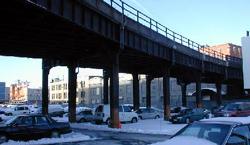

“Designing the High Line” is an exhibition of ideas for the conversion of the High Line elevated rail structure to public space. The exhibit is showing in Grand Central Terminal until July 26. 720 entries were submitted from 36 countries. More than 100 of the proposals, including the competition winners, are displayed in the Grand Central exhibit. All 720 entries are displayed on the Web site.
In addition to the four principal winners, designs were selected for special cash awards for depicting the most compelling solution for universal access to the elevated structure, and for incorporating plants and wild flowers native to New York. (Pictures are posted here and here, though difficult to read.)
The High Line runs for 1.45 miles over Manhattan’s West Side, from 34th Street down through Chelsea to Gansevoort Street in the Meat Packing District. The High Line was built during one of New York City’s largest infrastructure projects, the West Side Improvement project. The project took place in the early 1930’s during the Great Depression and was presided over by Robert Moses. The Line carried freight above the streets of the West Side until 1980, when the last boxcars hauled a load of frozen turkeys down the tracks. The structure has been inactive since, collecting trash, shedding rust, and sprouting an elevated garden of weeds and wildflowers. [more history here]
In 1992, the Chelsea Property Owners, a coalition of two dozen businesses who own property under and near the Line — mostly parking lots, machine shops, warehouses, and the trendy Chelsea Market — won a conditional demolition order from the Surface Transportation Board. The proposal to tear down the Line was later supported by Mayor Giuliani. The plan never materialized because the coalition and the railroad’s owner at the time, Conrail, could not agree on an ultimate price tag for demolition. [source]
Through the economic boom of the 90’s, however, new residents moved into the neighborhoods below the Line, among them artists, designers, and galleries. In 1999, an altogether different group of neighborhood residents founded Friends of the High Line, a 501(c)(3) non-profit organization with the mission of converting the structure to an elevated public space.
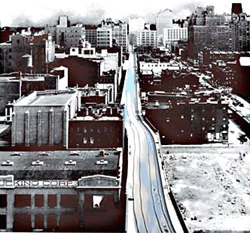 And, after much lobbying, it looks like the High Line might actually be redesigned. At the July 9 benefit preview of the exhibition, New York City Council Speaker Gifford Miller announced a $15.75 million funding commitment for planning and construction. The first $750,000 was allocated in the budget adopted by the New York City Council on June 27.
And, after much lobbying, it looks like the High Line might actually be redesigned. At the July 9 benefit preview of the exhibition, New York City Council Speaker Gifford Miller announced a $15.75 million funding commitment for planning and construction. The first $750,000 was allocated in the budget adopted by the New York City Council on June 27.
“The funds can be used for planning, design, and construction costs related to the High Line project during the fiscal year that began July 1. The remainder of the $15.75 million commitment will be allocated to the High Line in the following three fiscal years.
‘The High Line was built during the Depression to invigorate New York’s economy, and it will reinvigorate our City again today,’ said Speaker Miller. ‘As we have learned from our City’s great parks, public spaces create value and catalyze growth. Central Park was planned in a recession. Even in tough economic times, we have to invest in our future—by planning for the public projects that will keep us at the forefront of the world’s great cities.’
The funds will come from the City’s capital budget, which pays for project costs such as planning, design, construction, and long-term leases. The allocation will not affect municipal services, which are funded separately through the City’s expense budget.” [source]
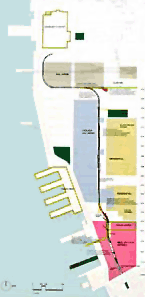 The Friends of the High Line are also seeking private, corporate, foundation, and federal funds for the project.
The Friends of the High Line are also seeking private, corporate, foundation, and federal funds for the project.
The competition follows two detailed planning studies: Reclaiming the High Line, sponsored by Friends of the High Line and the Design Trust for Public Space; and a comprehensive economic feasibility study, commissioned at the City’s request.
In December 2002, the City of New York took the first step in converting the High Line to a public walkway through federal rails-to-trails legislation. FHL is currently waiting on decision before Federal surface transportation board to allow City to move forward.
“As the next phase in its project to preserve and re-use the High Line, Friends of the High Line will hold a series of open workshops with members of the community beginning in September, with a variety of the competition proposals serving as springboards for discussion. At the end of 2003, Friends of the High Line will incorporate the community’s comments into a Request for Proposals, which will lead to the development of realizable designs.” [source]
The High Line is currently private property, owned by the rail company CSX Corporation. CSX acquired the High Line when it purchased Conrail in 1997. Conrail was created by the federal government in 1970’s from the remains of the New York Central and other railroads bankrupted by “competition from trucks, subsidized by the federally-built Interstate highway system, and an archiac system of economic regulations which prevented railroads from responding to the needs of the market.” The corporation was sold to the public in 1987, in what was then the nation’s biggest IPO. [more on Conrail] Though the High Line is private property, the federal government, specifically the Surface Transportation Board, has control over the Line as a piece of the nation’s rail infrastructure. CSX has been ordered by the government to work with all interested parties to effect the best exit strategy for the High Line, and to remain neutral as to the High Line’s outcome.
The City can not afford to purchase land under High Line, so has instead proposed rezoning and property transfer, moving air and development rights out to sites around West Chelsea. One potential consequence would be a wall of huge residential towers springing up along 10th and 11th Avenues in otherwise moderately sized manufacturing and retail zones. One challenge faced by city planners is the prevention such “massing.”
The High Line snakes through many neighborhoods and buildings, but sits almost entirely within the area served by Manhattan Community Board No. 4. The current Line blocks sunlight, collects trash, and drops water, rust, and pigeon droppings on the streets below. However, according to a survey by the Board, most community residents support conversion over demolition. They want to make sure, though, that the results of the redesign are the best damn park possible. The community is wary of new large-scale structures or billboards that would block sight of or access to the Hudson River. The project should provide open space for cultural programing, be accessible, and safe, providing a way to get up or down quickly. But most of all, it should connect with and respect the community. Some residential buildings sit within 5 feet of Line.
As development proceeds, areas beneath and adjacent to High Line will become lucrative spots for retail. Indeed, represenatives of our businessman-turned-Mayor is keen to move some of that retail up onto High Line itself. Other possibilities include constructing adjacent buildings with roof access that would meet the High Line or produce huge urban stairs, parks that terrace up to the bed of High Line, which is about 30 feet from the ground.
At a panel discussion, I asked Robert Hammond, co-founder of Friends of the High Line, about their advocacy strategy and how design competition fits into it. The competition took a year to organize from beginning to end and was a way to get people excited, to generate activism and support, and to provide a public platform for discussion. He noted the power of crazy, weird ideas - and how it is often easier to draw attention and support for the crazy ideas than the conservative plans. Another panelist noted that, when not located to a specific neighborhood, the constituency of public open space is transient and often does not have a consistent voice. The competition was an opportunity “to get those ideas out there.” Over the years, many have developed redesigns of the High Line for their thesis projects.
I asked Mr. Hammond what has led to their success to date while civic budgets are being cut and other projects around the city have faltered. Mr. Hammond proposed that the support base was “not the usual mix of neighborhood advocates.... The strongest supporters are architects, artists, art dealers.” Indeed a list of supporters at the gala benefit includes many A-list authors, actors, and artists. Not your usual city planning scene.
Mr. Hammond also noted that the design of their campaign materials was also key. Several designers have donated services to develop graphically sophisticated materials. Brochures, Web site, postcards for public comment... “Everything produced looks interesting. It suggests that the final design will be as innovative.”
Ironically, development of the High Line may push many in the arts community to leave the area. When the project is complete, rents around the Line are likely to increase. Many arts spaces are already midway through their 10 year lease, and unable to afford the current market rents. Part of the development plans could create public spaces that would not command retail rents and could support galleries, though these would be limited.
So how will the crazy ideas not get lost, or bogged down by politics? And allow ultimate designer to maintain poetic vision? The challenge is yet to come. Once New York realizes that the project is possible, everyone will want a piece of the action. It will be important to maintain a clear vision, and to make sure the final product is as extraordinary, interesting, and strange as the High Line itself.
Check out these photo galleries on the current state of the High Line.
The High Line was mentioned here in one of my first blog posts.
From an April 2002 interview in Metropolis Magazine:
“Rosanne Haggerty is the new landlord of the Andrews Hotel, a grim vermin-infested joint at the corner of Bowery and Spring Street on Manhattan’s Lower East Side. She is also founder and executive director of Common Ground Community, a nonprofit organization that has purchased and converted a handful of historic buildings, including the Times Square Hotel, into some of New York’s most progressive low-income housing — work that last year earned her a $500,000 ‘genius grant’ from the MacArthur Foundation.
After four years of field research that took Haggerty and her staff from the public shelters of New York to the capsule hotels of Japan, Common Ground Community is set to begin transforming the century-old Andrews into something they call First Step Housing. Working with New York architects Marguerite McGoldrick and Gans + Jelacic, and more than 150 homeless men and women who contributed feedback, Haggerty plans to combine elements of the Bowery’s dying flophouse tradition — $7 a night, no lease, no questions — with smart management, on-site social services, and space-efficient modular design. Recently she spoke with Douglas McGray about the project’s design considerations — and its lessons.”
Rosanne Haggerty:
“Social scientist Christopher Jencks zoned in on the loss of the cubicle hotels as a specific cause of the rise of single-adult homelessness. That got me thinking, Why don’t these places exist anymore? For years I’d get close to the question and then recoil because these buildings were so squalid. The quality-housing advocate in me couldn’t comprehend how one could responsibly advocate their resurgence. It finally occurred to me that until not-for-profits started working on them, single-room occupancies had also been looked at as substandard forms of housing. Then it clicked — it’s more of a failure of imagination on our part than anything embedded in the model.”
After extensive research, including two months in Osaka, Japan studying the flexible use of limited space, interviews with individuals and groups of homeless men and women, including feedback on three rounds of prototypes, Common Ground developed a design that was attractive, affortable, and secure.
“The main reason people are remaining on the streets is safety. They perceive themselves to be more secure sleeping in a public space than in the city’s shelter system. People were very keen on the idea of metal detectors, very concerned about what the roof material would look like — how secure it would be. They were concerned about the strength of the lock and the durability of the construction....
Somebody had a very good line. He said, ‘You don’t want it to be a doll house, but you don’t want it to be a cell either.’ A lot of these folks have been in psychiatric hospitals or in jail, and they don’t want an environment that reminds them of that. Things as subtle as being able to move the furniture around — not having it nailed down — being able to get control of a degree of privacy in the space, having a window that opens and closes onto a central corridor seemed to take something that could have been viewed as institutional and make it cozy....
Frankly, design makes a significant difference in terms of the atmosphere of calm and respect that you establish. People respond behaviorwise to being in that kind of environment. Keeping maintenance costs reduced is also a consideration. We need spaces that can be cleaned easily, panels that can be removed and replaced without having to trash the whole unit.”
The First Step units are prefabricated, ship nearly flat and can bolt together in almost any commercial space.
Many of the housing projects incorporate social services:
“Supportive housing is permanent housing with social services for the formerly homeless, people with mental and/or medical disabilities, the elderly, and individuals with low-income. Supportive housing combines affordable accomodations with services like mental health and drug addiction counseling, job training and placement, community activities, and help with life skills like cooking and money management.
Supportive housing was created by non-profits around the country as a more holistic response to homelessness. Approximately 70% of homeless single adults in the United States have problems like mental illness, substance abuse and HIV/AIDS — problems which contribute to their homelessness. By offering a variety of support services designed to address these issues, supportive housing has paved the way for a more effective approach to preventing homelessness....
Two long-term government studies have shown that more than 83% of the homeless individuals placed in supportive housing have remained in permanent housing and have reintegrated themselves into mainstream society.”
See the Corporation for Supportive Housing and the Supportive Housing Network of New York.
Common Ground and the Architectural League of New York are currently running an open competition to design a new “prefabricated individualized dwelling unit.” The registration deadline is July 11, 2003. The design entry submission deadline is 10 AM, August 25, 2003.
“Up to four competition winners will be chosen. Winners will each receive a cash prize of $2,000 and will be engaged to develop their proposals for manufacture and installation at the Andrews House, a lodging house on the Bowery in Manhattan, for which they will be paid a design fee. An exhibition of entries will be mounted in Manhattan in October 2003, and displayed on the competition website. A publication documenting the competition may also be produced.”
See the First Step Housing Web site for more detail.
page 1 2 3 4 5 6 7 8 9 10 11 12 13 14 15 16 17 18 19 20 21 22 23 24 25 26 27 28 29 30 31 32 33 34 35 36 37 38 39 40 41 42 43 44 45 46 47 48 49 50 51 52 53 54 55 56 57 58 59 60 61 62 63 64 65 66 67 68 69 70 71 72 73 74 75 76 77 78 79 80 81 82 83 84 85 86 87 88 89 90 91 92 93 94 95 96 97 98 99 100 101 102 103 104 105 106 107 108 109 110 111 112 113 114 115 116 117 118 119 120 121 122 123 124 125 126 127 128 129 130 131 132 133 134 135 136 137 138 139 140 141 142 143 144 145 146 147 148 149 150 151 152 153 154 155 156 157 158 159 160 161 162 163 164 165 166 167 168 169 170 171 172 173 174 175 176 177 178 179 180 181 182 183 184 185 186 187 188 189 190 191 192 193 194 195 196 197 198 199 200 201 202 203 204 205 206 207 208 209 210 211 212 213 214 215 216 217 218 219 220 221 222 223 224 225 226 227 228 229 230 231 232 233 234 235 236 237 238 239 240 241 242 243 244 245 246 247 248 249 250 251 252 253 254 255 256 257 258 259 260 261 262 263 264 265 266 267 268 269 270 271 272 273 274 275 276 277 278 279 280 281 282 283 284 285 286 287 288 289 290 291 292 293 294 295 296 297 298 299 300 301 302 303 304 305 306 307 308 309 310 311 312 313 314 315 316 317 318 319 320 321 322 323 324 325 326 327 328 329 330 331 332 333 334 335 336 337 338 339 340 341 342 343 344 345 346 347 348 349 350 351 352 353 354 355 356 357 358 359 360
[ Back ]
[ Next ]


